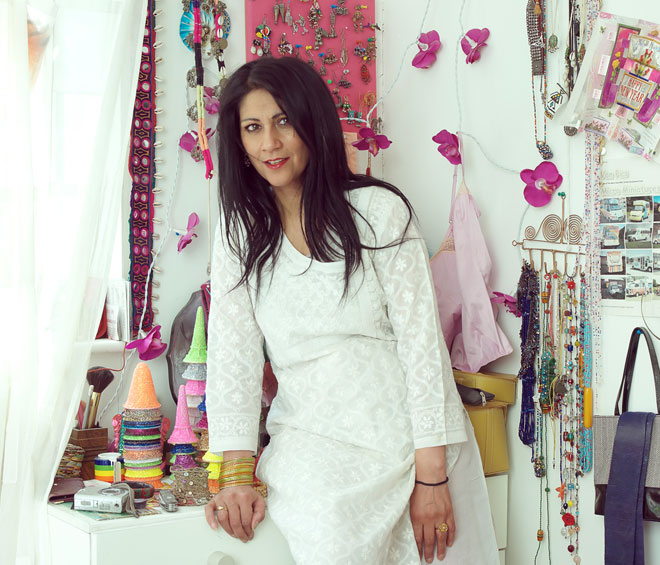
by JANET McKENZIE
Chila Kumari Burman was born in Bootle in Merseyside in 1957, brought up in Liverpool and educated at Leeds polytechnic (now Leeds Metropolitan University) and the Slade School of Fine Art, London. Since the 80s, her dynamic and experimental work across printmaking, installation, painting, sculpture, photography and film has explored Asian femininity. Employing a wide range of materials from Bollywood bling, she challenges stereotypical assumptions about Asian women. Her work evokes essentially female cultural icons that resonate with multiple selfhoods from her dual cultural experiences.

Chila Kumari Burman. India Illuminated installation, commissioned by the Science Museum, London, in response to 5,000 years of India’s scientific inventions, October 2017 – April 2018. 29 mixed media works.
At the recent exhibition Illuminating India: Photography 1857-2017, at the Science Museum in London, Burman presented India Illuminated, a parallel show of 29 of her exquisitely worked images, commissioned by the museum. By selecting motifs from the history of India, as presented through the survey of photography, Burman’s wall of images provided an individually focused representation of the country’s history in “a punk philosophical Indian style to show the highly esteemed connection between Indian science and art”. In the museum’s foyer, an Indian tuk-tuk, on loan from the artist and decorated by her, acted as a beacon to lead visitors into the gallery upstairs.
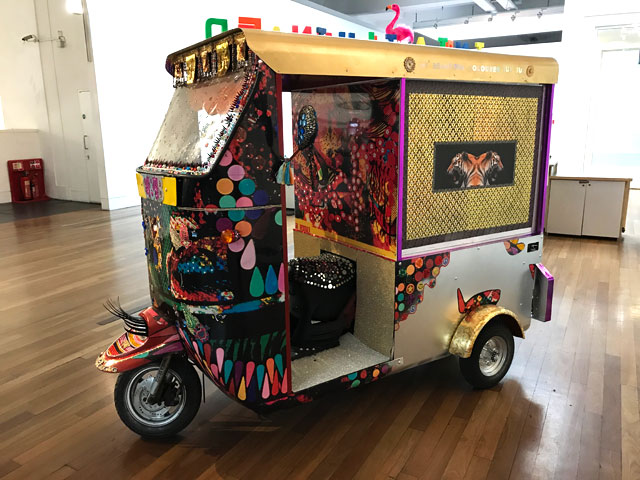
Chila Kumari Burman. My Valiant Queen Tuk Tuk, 2017-18. Mirror glass, plastic eyelashes, fabric, rhinestones, Swarovski gems, washi tape, rakhis, bindis, Columbo gems, wrapping paper, gold spray paint, stickers, fake gems, fairy lights, Christmas decorations, feather flamingo, wood, plastic, stickers, satin tassels, paper flowers.
Burman’s work will also be on show in London on 22 July as part of Motive/Motif: Artists Commemorate the Suffragettes. The show has been curated by Charlotte Hodes and Alison Moloney at the London College of Fashion, UAL, who have commissioned 20 renowned and emerging artists and designers to create an embroidered handkerchief to mark women’s suffrage and the passing of the 1918 Representation of the People Act that extended voting rights to some women. Hodes says: “The starting point for this project is a handkerchief that was embroidered in 1912 by suffragettes who were imprisoned at Holloway prison. Most of the women who signed the handkerchief participated in demonstrations in March 1912 organised by the Women’s Social & Political Union. They were denied the status of political prisoners and many were force-fed. The significance of the image on the handkerchief goes far beyond this modest embroidered object. Its beauty belies the women’s struggle and suffering whilst revealing their bond with the embroidered word. The contemporary handkerchiefs that commemorate the Suffragettes will be exhibited alongside the original 1912 handkerchief, which is on loan from the Priest House and Sussex Archaeological Society, West Sussex.”
While her work was still on show at the Science Museum, Burman talked about her work for both exhibitions.
Janet McKenzie: You grew up in Liverpool and, in the 1970s, you chose to attend art school to avoid an arranged marriage. How did you make the transition from your Punjabi family values to the life of an artist, and how did your family respond?
Chila Kumari Burman: When I was at Leeds polytechnic I had to stay with my cousin there (I got a first-class honours degree) and when I was at the Slade I had to stay with my Parsi Auntie Babsy, who was a nurse in Wormwood Scrubs prison. As long as I stayed with family, my mum and dad were cool. They were well proud of me doing an MA and, even though they were illiterate, they were visionaries and understood art in their own way.
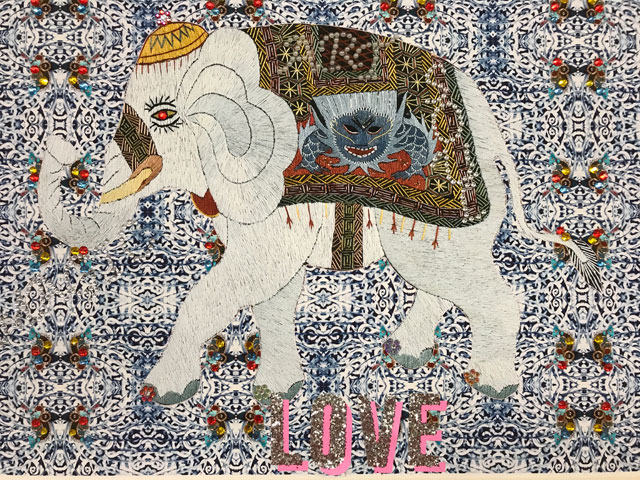
Chila Kumari Burman. Best Love Elephant in Town, 2018. Rhinestones, glitter, embroidery on Dibond.
JMcK: We are at the Science Museum in London, an impressive venue for the exhibition of your work, and we are looking at the group of 29 works, made using a wide range of jewels, threads, elephant motifs and objets trouvés. One of the elephants, My Dazzling Pink Soda Elephant Raising the Roof (2018) is on wrapping paper, although it looks as if it is made with layers of gold leaf.
CKB: These elephant images were the first images made in this series. I was going to do one big elephant. The Science Museum wanted me to do the work in response to its photographic exhibition. I was on my way to Colombo in Sri Lanka for three weeks and, by the time I got back, I had decided to do one big image of an elephant. I did this one but I realised that I only had a limited space, and then the people I worked with here at the Science Museum asked if I could include particular images from the photographic works, such as the surgical Ayurvedic tools with animal heads representing a wolf, a lion, a snake. I then used my Indian bling style and covered them in gold leaf. I was asked to include images from Indian mythology, the Jain symbol; they asked if I could also put in something about Islam. With the disparate requirements, I said I would like to do a salon hang. Then, when I did this jewelled elephant, I filled it with bindis that wouldn’t have worked as a giant piece. I researched elephants mostly by watching documentaries – so much so that fell in love with them. I figured out they were extraordinary creatures; they are frighteningly powerful but also very tender.
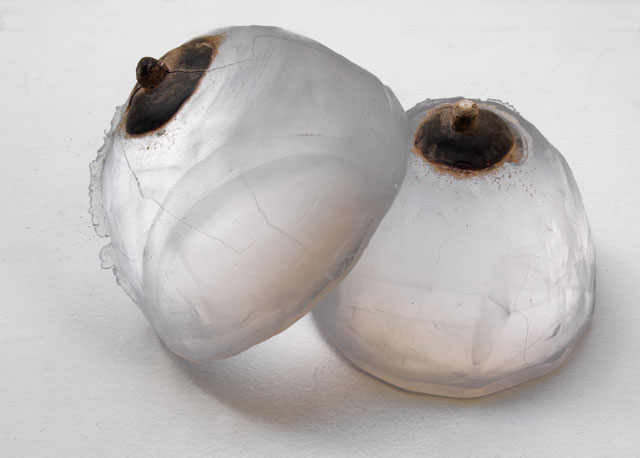
Chila Kumari Burman. My Breasts, 2012. Glass. Larger than life-size.
Near to where I stayed in Colombo, there were loads and loads of shops with gemstones. I came back from Sri Lanka with a suitcase full of gems. That’s why I came to use them. Colombo is famous for its elephants – every tourist object has elephant motifs on it. Elephants look as if they carry a lot of weight, so the beads on My Dazzling Pink Soda Elephant Raising the Roof make it look as if it is carrying pulleys, which creates a formal dynamic. I also made all these baby elephants: Adore, Wild, Pleasure and Rhythm (all 2018). I couldn’t stop making elephants, one a day. I was getting worried about the commission – I thought maybe if I made 100 elephants it would work out OK.
JMcK: Can you tell me about the two Snakes and Ladders works: an Indian version and an English version?
CKB: I discovered independently that the board game Snakes and Ladders was invented in India. I have a friend who is head of South Asian arts at the Victoria and Albert Museum and, through her, I got an inkjet print of the original and then embellished it. The original boards form the basis of each image – an Indian and an English one.
JMcK: The original board game was a game of life, concerned with morality (ladders) and vices (snakes). Why have you highlighted “Poverty” and “Gambling” in your embroidered words on the work?
CKB: Because they are all on the original game board. The game Snakes and Ladders was about the path of life – the ladder is the path to heaven and the snake sees you come crashing down.
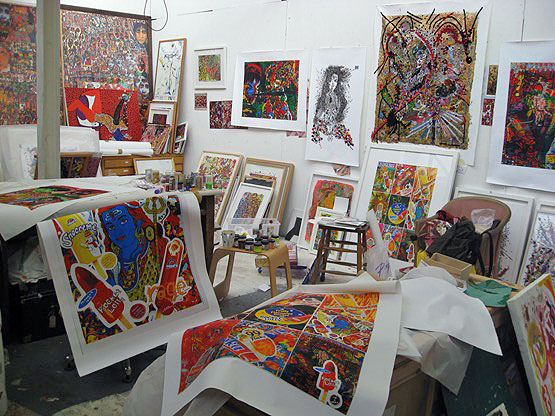
Installation view of Inside My Space Studio, Deborah House , Hackney, London, 2001–15.
JMcK: How did you come to work in sewn lines and employ a wide range of jewels and beads?
CKB: My mother used to sew. My father was a tailor and an ice-cream man. We come from the tailoring caste in India. Women usually knit and crochet outstandingly well, really clever and very fast. My work incorporates the female activities of making, of sewing and of embroidering. My mother used to embroider just a little. I remember she embroidered small flowers on pillowcases. She was a very sociable, a chatterbox (like me) and an entertainer. My father was a magician: he ate fire, swallowed swords and performed party tricks on stage. My mum would instigate naughty jokes. Also, Liverpudlians and Punjabis are both very much in your face, very funny and entertaining.
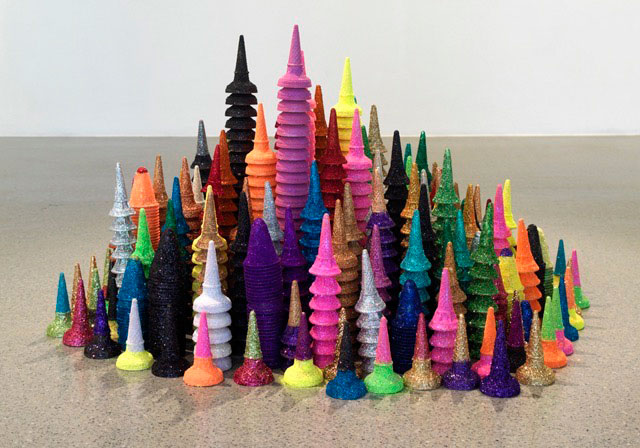
Chila Kumari Burman. Cornets and Screwballs Go Vegas, 2012. Biscuit, plastic, glitter, spray mount, cornets and screwballs, 200 x 100 cm.
JMcK: Your family found a good culture to connect with?
CKB: Yes, we were dead lucky.
JMcK: You are also contributing to the Suffragette handkerchief exhibition as part of Motive/Motif: Artists Commemorate the Suffragettes?
CKB: This is the handkerchief. Originally, I wanted to make it girly and beautiful. I’m dead chuffed with it.
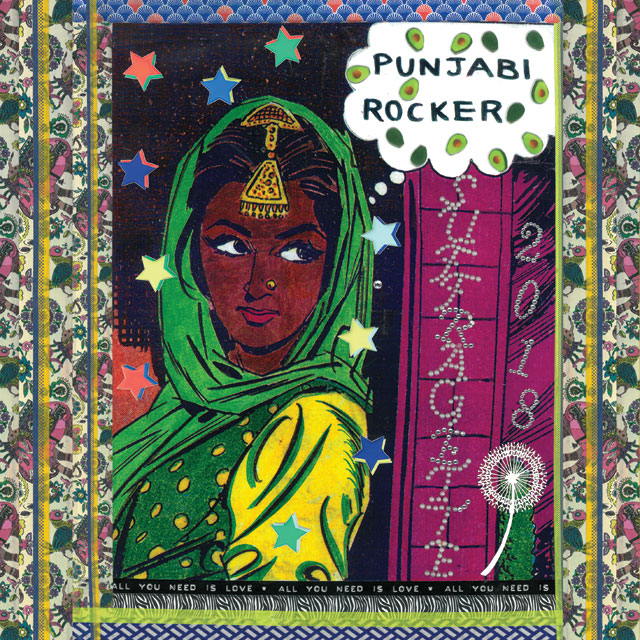
Chila Kumari Burman. Punjabi Rocker, 2018. Design for suffragette handkerchief for the London College of Fashion exhibition Motive / Motif, to mark Women’s Suffrage and the passing of the 1918 Representation of the People Act. Here East, Queen Elizabeth Olympic Park, London, 22 July 2018.
JMcK: Which artists historically have been most important influences for you?
CKB: When I had to write a dissertation at art school, I chose Dada and surrealist artists. I was interested in the movements as social and political ones. I was interested in psychoanalysis and politics and I liked Max Ernst, Jean Tinguely, bits of Marcel Duchamp and André Breton’s automatic writing. I only recently came across Leonora Carrington and Méret Oppenheim, who did the fur-covered cup (Object Paris, 1936). There were very few women.
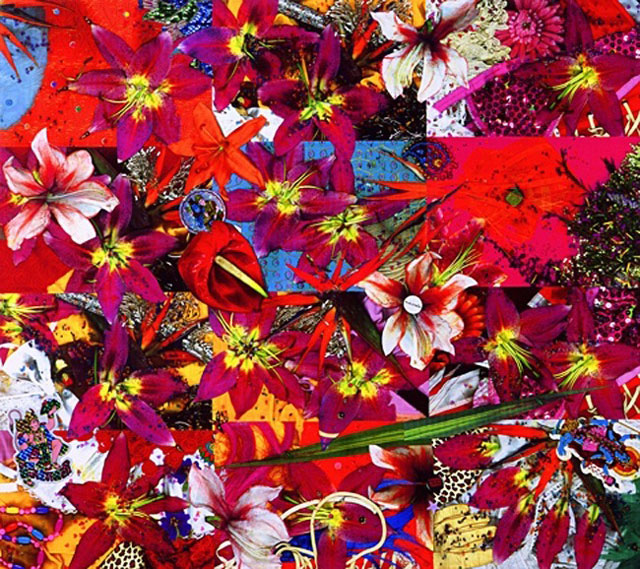
Chila Kumari Burman. Ganesh with Lillies / Undesirable, 2012. Giclée print on Hahnemuhle fine art paper embellished with bindis and rhinestones, 34 x 47 in.
JMcK: Did Paula Rego teach you at the Slade?
CKB: No, I was in printmaking. In the two years that I was at the Slade, of all the visiting artists who came to give talks, there were no women. My whole art career has been around men.
JMcK: What do you find in the handkerchief project that most appeals to you?
CKB: I was so chuffed to be asked. It was a surprise. I have academic friends who have contributed to a publication on the suffrage anniversary and they drew my attention to Princess Singh (1876-1948) who was a prominent suffragette in the UK. Her father had been taken from his kingdom of Punjab to the British Raj and was subsequently exiled to England. Princess Singh’s godmother was Queen Victoria.
Only 20 artists were commissioned for the handkerchief project and although the final work had to be a certain size, I could do whatever I liked. The image came from a work on my studio wall: my late baby brother and I had considered using it for our other brother’s CD cover. It’s an image taken from a comic-book character Punjabi Rockers and it is also one of the sound tracks on my brother’s album. The music sounds quite like reggae; the CD is a mixture of Punjabi music and reggae music and I used it recently as the soundtrack for my recent animation, Dada and the Punjabi Princess. It hasn’t been released yet, but there are clips on my website, about a minute of it. The animation does look like the handkerchief for the exhibition. Harriett Brown, who is transferring the artists’ designs using an embroidery machine at the London College of Fashion, found it too complicated to embroider so she sourced some tape at Shepherd’s Bush market, which she is hand-stitching to the main image.
She’s adapting each design and, in the case of mine, she has improved the design, adjusted the details and been very conscientious. It’s the girls team together.
JMcK: It’s a fabulous image. There are numerous artists in their 60s who are doing some very interesting work, who, for one reason or another, are redefining themselves through their art.
CKB: The good thing about being an artist is that we carry on playing. That’s why we look young – because we don’t have a boss. You have to be fit to be an artist – to pull an etching press, to make silk-screen prints. The work is hugely energetic. My wellbeing is also down to having a great acupuncturist; she’s dynamic and she allows me to keep going and going. Artists are slightly outside the system. I avoid anybody who is going to upset my confidence.
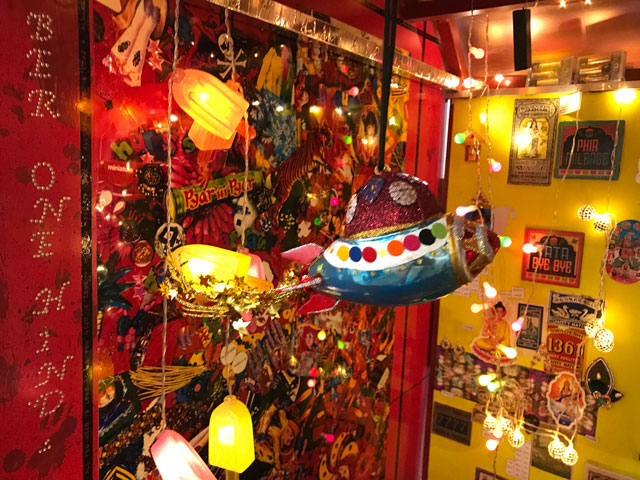
Chila Kumari Burman. Valiant Queens, 2017–18. Interior view of my tuk tuk. Fairy lights, Christmas decorations, pearls, super high-gloss print of Punjabi Rockers coasters, washi tape, fridge magnets, rhinestones.
JMcK: Tell me about your tuk-tuk in the foyer of the Science Museum?
CKB: I have loaned it to the museum. In the north of India, in the region of the Ganges Mountains, you see a lot of tuk-tuks like that one. It’s typical of the poor part of the Punjab. You see fancy ones that the boys are driving: they are OK, but I prefer the local ones. An Englishman whose wife is Indian bought this tuk-tuk to use to sell Indian ice-cream in Leeds, found my work online and sent me an email saying he wanted to buy one of my images to put on the front of it as decoration. I said, of course. He bought the copyright to produce it. Later, I was asked by the Science Museum if I knew how to acquire a tuk-tuk for the present exhibition, so I phoned the man and he said he was planning to sell it. He tried to sell it on eBay for £5,000 but failed, so I offered him £2,000 and now I have it on loan to the Science Museum. Of course, it didn’t sell for £5,000. It’s made of tin and the motor doesn’t work! Flippin’ heck! I didn’t tell him it was for the Science Museum because he would have wanted a higher price. When the exhibition closes, it comes back to me and I am lending it to my friend Roger for Yum Sa, his fab Thai restaurant in East Putney. I want to take it places.
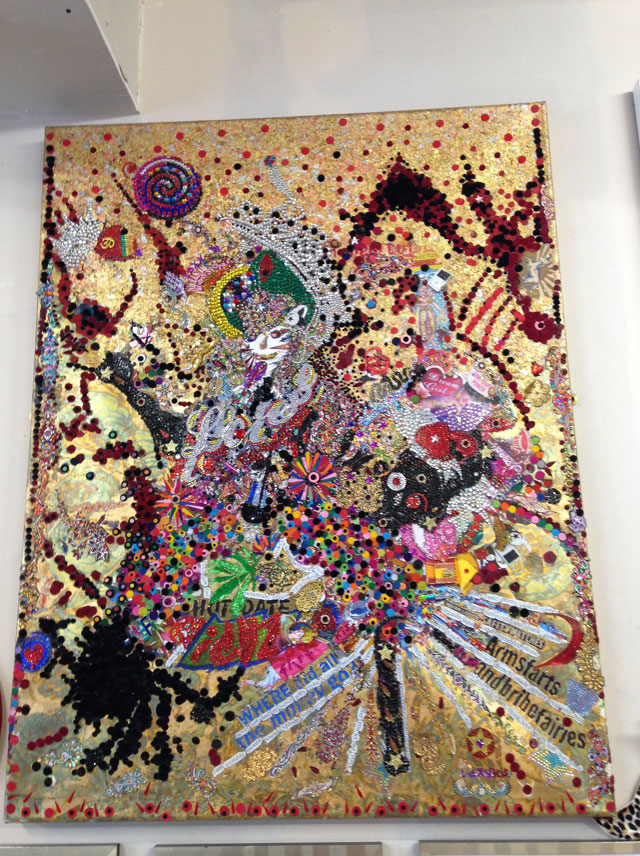
Chila Kumari Burman. Where Did All The Money Go, 2013. Vajazzling, bindis, rhinestones, Swarovski gems, gold leaf, inkjet, body stickers, erotic fridge magnets, glitter, Letraset, on canvas, 34 x 47 in.
JMcK: Your embroidery can be seen as a form of drawing. As a print-maker, you have a strong graphic sense. Can you describe the role of drawing in your practice?
CKB: My drawings take the form of collages, assemblages and sculpture and I create cut-outs with scissors. I scribble and make a mess in my studio. My mixed-media drawings are intense and political. They are fun, playful, cheeky, rude, hard and soft, happy and sad. They are fashionistic magical journeys into an underworld. My whole studio is one big drawing, which I must exhibit one day soon. I have an etching press in my studio where I ink up a lithographic plate with Indian blue etching ink and draw with cotton buds. I have a sketchbook next to my bed, so I use a big fat lead pencil and I draw most nights. It’s like a secret intimate drawing session – a release. My Dada and the Punjabi Princess film is one long drawing animation and so too is my Candy Pop and Juicy Lucy film.
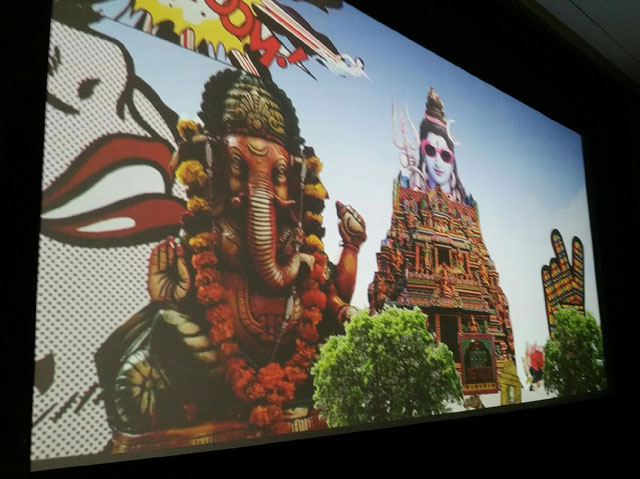
Chila Kumari Burman. Dada and Punjabi Princess, 2017. Moving image, 10 mins duration. Screened at FACT Liverpool for Lightnight Liverpool Festival 2017.
JMcK: Can you explain what it is like drawing on an iPad after your traditional drawn works in a range of materials?
CB: I draw on my iPad and iPhone with my fingers. Art is best made using our hands; the mind-body-spirit connection is crucial to stay energised. I use a basic app with a basic colour palette. I scribble, I press lightly and hard with my fingers. The iPad drawings are usually non-figurative, sometimes with cheeky faces and smiles and eyes and words. My iPad drawings are scary journeys into the unknown; they are unconscious as well as conscious ready-mades and they are very energetic. Through working in this way, I feel I’m widening the gaze. They are generally made quickly on the bus, on the way home from the studio, on a train journey, in waiting rooms, in bed slowly, anywhere that my iPhone or iPad doesn’t wobble too much.
• Motive/Motif: Artists Commemorate the Suffragettes is at Here East, Queen Elizabeth Olympic Park, London on 22 July 2018.